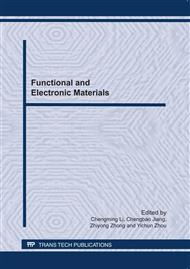p.750
p.756
p.759
p.765
p.771
p.778
p.784
p.791
p.798
The Microstructure, Resistivity and Infrared Emissivity of ITO Film with O/Ar Ratio Variation in Al2O3 Buffer Layer
Abstract:
ITO films with different oxygen-argon ratios varies from 0 % to 8 % for Al2O3 buffer layer have been fabricated by magnetron sputtering on soft PET substrate. The microstructure, resistivity, transmittance in visible light range and infrared emissivity were measured by XRD, four-point probe technology, UV-Vis spectrophotometer and Fourier Transform Infrared Spectroscopy (FTIR) as a function of different oxygen-argon ratios of Al2O3 buffer layers, respectively. It can be found that the (222) plane crystallization improves with the increase of O/Ar ratio, (622) peak under 2% O/Ar ratio and (440), (211) peaks under 8% O/Ar ratio appear, respectively. The resistivity is also influenced significantly by the O/Ar ratio, though the variation of resistivity is not sensitive to O/Ar ratio higher than 2%. The results reveal that the best ITO film performance under the oxygen-argon ratio 2% for Al2O3 buffer layer. It is also found that surface roughness and interface state play an important role in the variation of transmittance and emissivity. The emissivity of all the ITO films deposited on Al2O3 buffer layer is dominated by both sheet resistance and surface morphology.
Info:
Periodical:
Pages:
771-777
Citation:
Online since:
June 2011
Authors:
Keywords:
Price:
Сopyright:
© 2011 Trans Tech Publications Ltd. All Rights Reserved
Share:
Citation:


